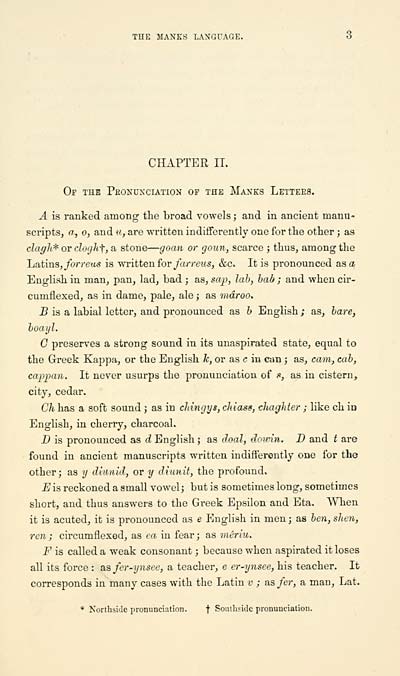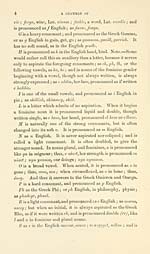Blair Collection > Practical grammar of the antient Gaelic, or, Language of the Isle of Man, usually called Manks
(51)
Download files
Complete book:
Individual page:
Thumbnail gallery: Grid view | List view

THE MANKS LAXGUAGE.
CHAPTER II.
Of the Peonuxciation of the Manks Letters.
A is ranked among the broad vowels ; and in ancient manu-
scripts, a, o, and u, are written indifferently one for the other ; as
clagli* or doghf, a stone — goan or goun, scarce ; thus, among the
Jjatins, for reus is written for /arretts, &c. It is pronounced as a
English in man, pan, lad, bad ; as, sajJ, Jah, hab ; and when cir-
cumflexed, as in dame, pale, ale ; as mdroo.
jB is a labial letter, and pronounced as b English ; as, hare,
hoayl.
C preserves a strong sound in its unaspirated state, equal to
the Greek Kappa, or the English k, or as c in can ; as, cam, cab,
cappan. It never usurps the pronunciation of ^, as in cistern,
city, cedar.
Ch has a soft sound ; as in cldngys, cJdass, chaglder ; like ch in
English, in cherry, charcoal.
D is pronounced as d English ; as doal, dowin. D and t are
found in ancient manuscripts written indifferently one for the
other; as y diumd, or y diunU, the profound.
Eh reckoned a small vowel j but is sometimes long, sometimes
short, and thus answers to the Greek Epsilon and Eta. AYhen
it is acuted, it is pronounced as e English in men; as hen, shen,
ren ; circumflexed, as ea in fear; as menu.
F is called a weak consonant ; because when aspirated it loses
all its force : Sbsfer-ynsee, a teacher, e er-ynsee, his teacher. It
corresponds in many cases with the Latin v ; as/e?-, a man, Lat.
* Korthside pronunciation. f Souihsidc pronunciation.
CHAPTER II.
Of the Peonuxciation of the Manks Letters.
A is ranked among the broad vowels ; and in ancient manu-
scripts, a, o, and u, are written indifferently one for the other ; as
clagli* or doghf, a stone — goan or goun, scarce ; thus, among the
Jjatins, for reus is written for /arretts, &c. It is pronounced as a
English in man, pan, lad, bad ; as, sajJ, Jah, hab ; and when cir-
cumflexed, as in dame, pale, ale ; as mdroo.
jB is a labial letter, and pronounced as b English ; as, hare,
hoayl.
C preserves a strong sound in its unaspirated state, equal to
the Greek Kappa, or the English k, or as c in can ; as, cam, cab,
cappan. It never usurps the pronunciation of ^, as in cistern,
city, cedar.
Ch has a soft sound ; as in cldngys, cJdass, chaglder ; like ch in
English, in cherry, charcoal.
D is pronounced as d English ; as doal, dowin. D and t are
found in ancient manuscripts written indifferently one for the
other; as y diumd, or y diunU, the profound.
Eh reckoned a small vowel j but is sometimes long, sometimes
short, and thus answers to the Greek Epsilon and Eta. AYhen
it is acuted, it is pronounced as e English in men; as hen, shen,
ren ; circumflexed, as ea in fear; as menu.
F is called a weak consonant ; because when aspirated it loses
all its force : Sbsfer-ynsee, a teacher, e er-ynsee, his teacher. It
corresponds in many cases with the Latin v ; as/e?-, a man, Lat.
* Korthside pronunciation. f Souihsidc pronunciation.
Set display mode to: Large image | Transcription
Images and transcriptions on this page, including medium image downloads, may be used under the Creative Commons Attribution 4.0 International Licence unless otherwise stated. ![]()
| Early Gaelic Book Collections > Blair Collection > Practical grammar of the antient Gaelic, or, Language of the Isle of Man, usually called Manks > (51) |
|---|
| Permanent URL | https://digital.nls.uk/81514034 |
|---|
| Description | A selection of books from a collection of more than 500 titles, mostly on religious and literary topics. Also includes some material dealing with other Celtic languages and societies. Collection created towards the end of the 19th century by Lady Evelyn Stewart Murray. |
|---|
| Description | Selected items from five 'Special and Named Printed Collections'. Includes books in Gaelic and other Celtic languages, works about the Gaels, their languages, literature, culture and history. |
|---|

